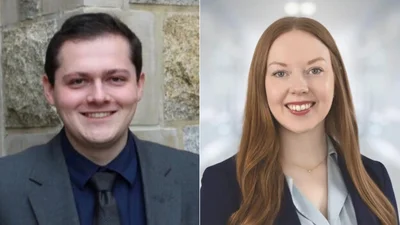U.S. Department of Energy (DOE) Office of Legacy Management (LM) staff supported outreach for the Atomic Legacy Cabin (ALC) at two STEM events in January for Pomona Elementary School in Grand Junction, Colorado.
Bill Frazier, an LM site manager and civil engineer, speaks to students at Pomona Elementary School in Grand Junction on Jan. 19. Photos courtesy of Rachelle Horner/Mesa County Valley School District 51.
On Jan. 19, LM site manager Bill Frazier spoke with fifth-grade problem-based learning students about how he has used art in his career as an engineer, said School District 51 STEM coordinator Rachelle Horner.
The students are presenting an argument that art should stay in STEAM (science, technology, engineering, art and math) because of the importance of art to all careers.
“Our goal from this presentation was to help students think outside the box about how art, creativity and design are important elements for success in many career paths, not just to become an ‘artist,’ ” Horner said.
“Bill was able to show the students photos of past projects, and explain to them how, as an engineer, he had to make decisions that employed sound engineering practices but balanced the artistic or aesthetic goals of the project that were also valuable and made the environment he was improving a pleasant place to be,” she said.
Frazier’s presentation helped students broaden their understanding of a variety of career paths in engineering and construction, and explained how rounding out their skill sets to include art and design can help take an engineer's work to a new level, Horner said.
LM Site Manager Kate Whysner gives a presentation at Pomona Elementary School’s Science Night at Eureka! McConnell Science Museum in Grand Junction on Jan. 25.
At the second event on Jan. 25, LM site manager Kate Whysner taught students about yo-yo energy at Pomona’s Science Night at Eureka! McConnell Science Museum in Grand Junction. Whysner explained potential and kinetic energy, and the conversion of mechanical to electrical energy. She challenged the students to guess how many hours of yo-yoing it would take to charge a light bulb or a cellphone.
“A simple game like a yo-yo can be even more fun when you think about all of the forces and types of energy that are involved,” Whysner said.
Her visit with Pomona students was her first STEM with LM event, and she’s excited to volunteer for more.
“To watch a student have an “Aha!” moment when they get to apply a concept they learned at school to something they experience in the real world is so rewarding,” she said.
Pomona Principal Bil Pfaffendorf said he was happy students got to participate in Whysner’s activity, which he hopes encourages them to consider possible careers in STEM fields.
“This is really important because kids, especially our girls, were able to see a professional female role model,” he said. “One thing that we ensure at Pomona is that we become scientists, not just ‘do science,’ and that boys are girls are both hard workers, knowledgeable, and are great partners.”
Whysner’s yo-yo lesson was particularly enjoyable, Pfaffendorf said, because the fifth-graders are really into yo-yo tricks this year. He said he overheard students talking about the "forces" they learned about at science night. The kids made all kinds of real-world connections, he said.
“It was pretty cool to hear those side conversations on the playground or classrooms,” he said. “Kate did a fantastic job of letting kids wonder, be curious, and let them struggle when she asked them questions.”
Pfaffendorf said it’s very important to have students engage with professionals who work in STEM-related fields.
“This is one reason we moved to a STEAM school using problem-based learning as a platform,” he said. “Kids get to see, listen and work with professionals from our community or around the world. All the adults that we have engaged with have been beyond professional.”









